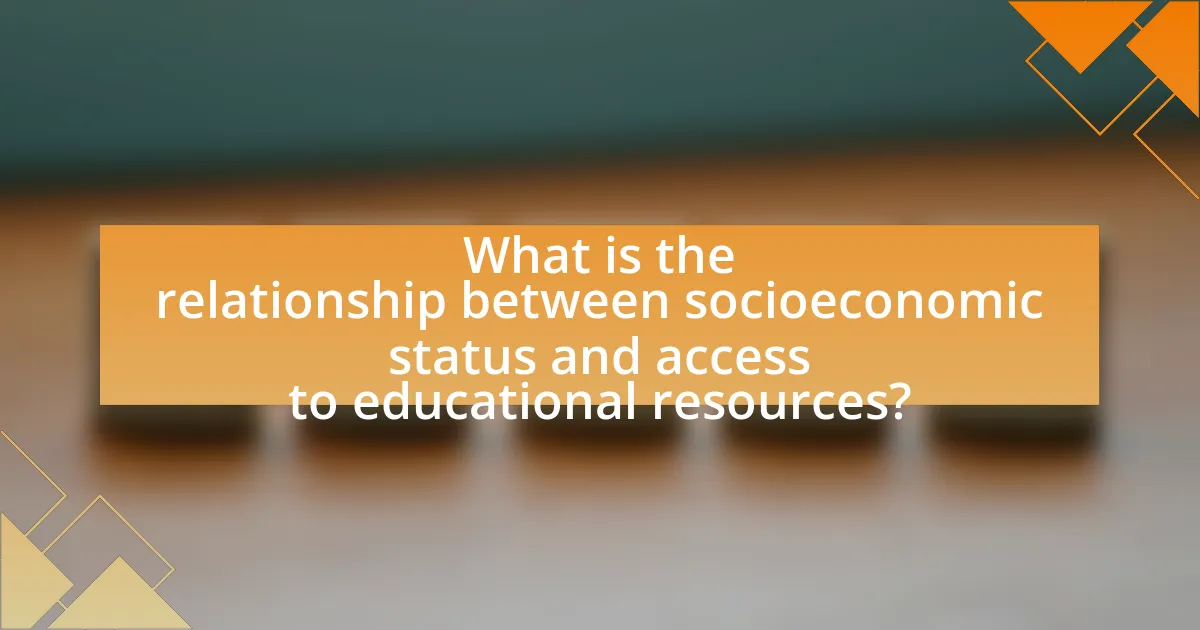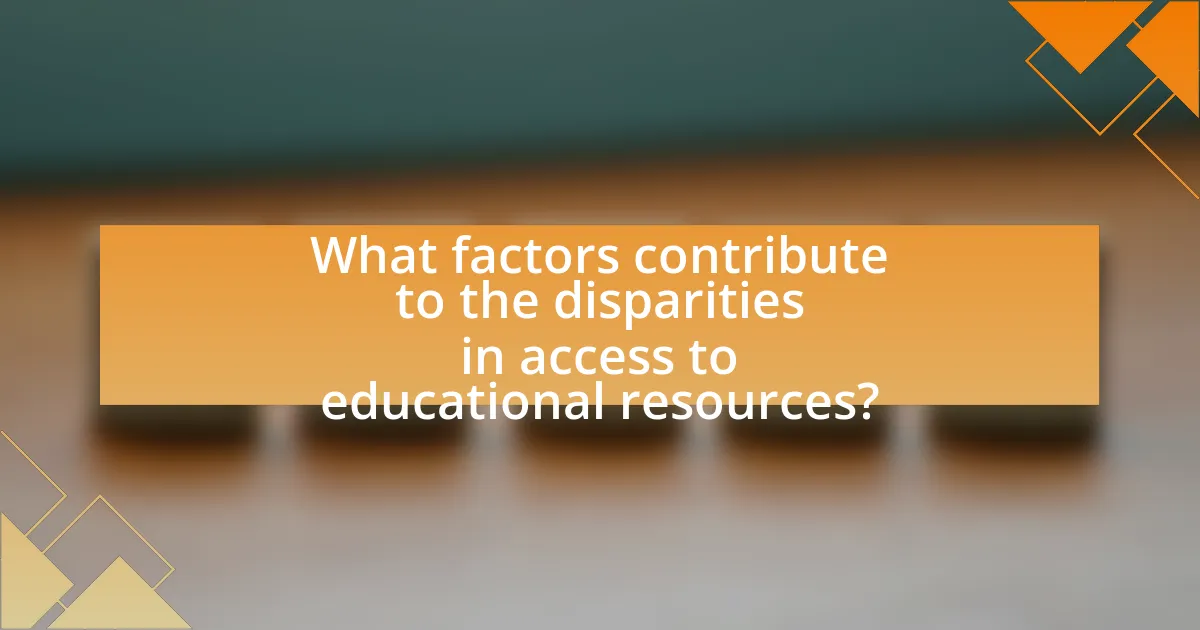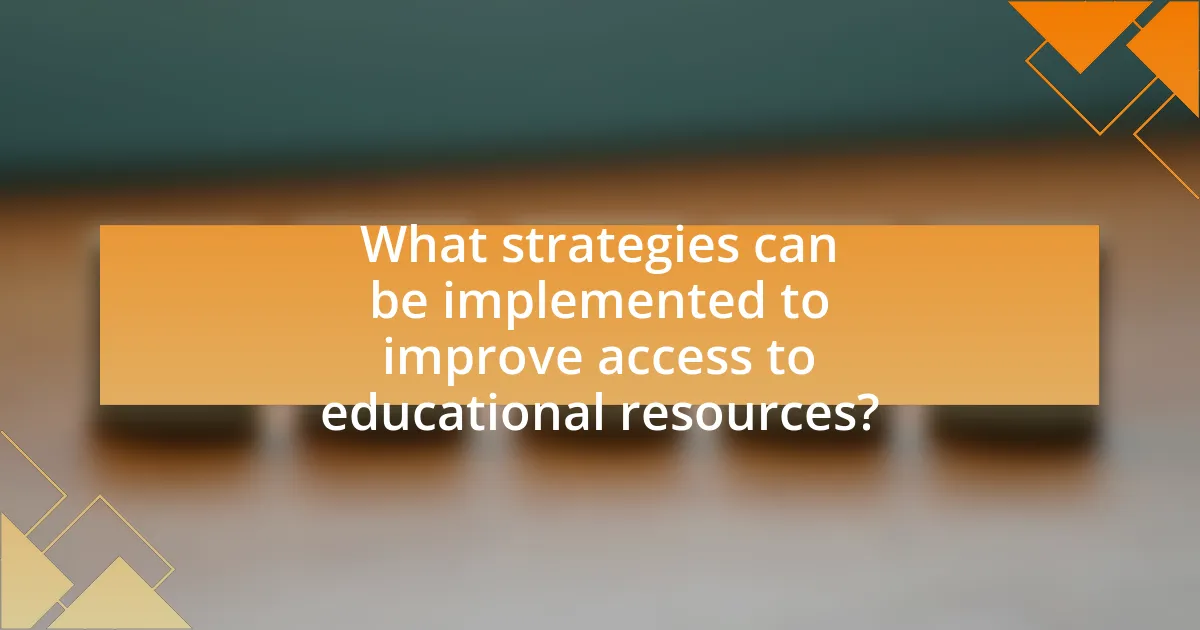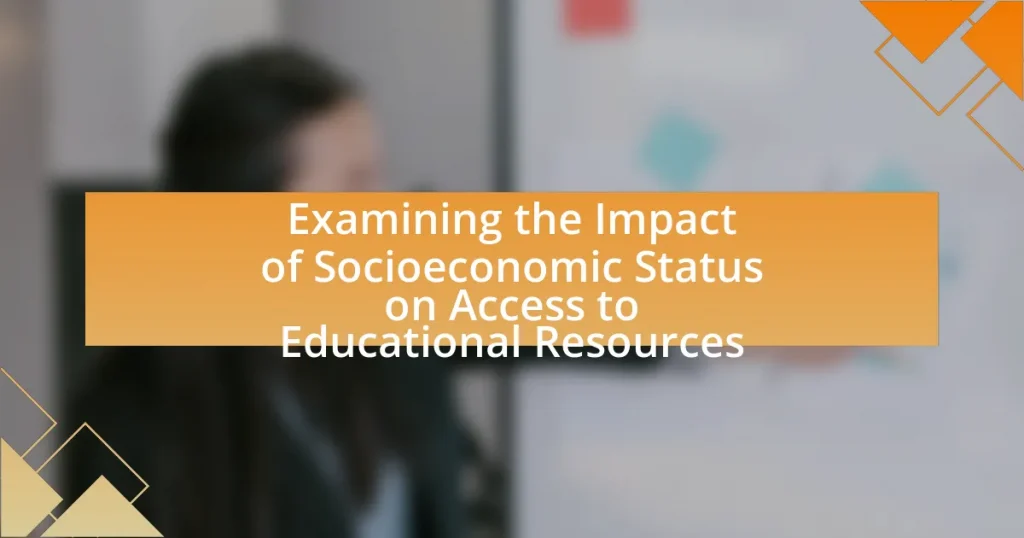The article examines the impact of socioeconomic status on access to educational resources, highlighting how individuals from higher socioeconomic backgrounds benefit from superior educational materials, experienced educators, and advanced technology. It discusses the disparities in educational opportunities faced by low-income families, including limited access to quality schools, extracurricular activities, and essential resources, which contribute to unequal educational outcomes and perpetuate cycles of poverty. The article also explores systemic barriers, the role of parental education, neighborhood quality, and funding disparities, while suggesting strategies for improving access to educational resources through community programs, policy changes, and equitable funding models.

What is the relationship between socioeconomic status and access to educational resources?
Socioeconomic status significantly influences access to educational resources. Individuals from higher socioeconomic backgrounds typically have greater access to quality educational materials, experienced educators, and advanced technology, which enhances learning opportunities. For instance, a study by the National Center for Education Statistics found that students from low-income families are less likely to have access to advanced coursework and extracurricular activities compared to their higher-income peers. This disparity in access can lead to unequal educational outcomes, perpetuating cycles of poverty and limiting social mobility.
How does socioeconomic status influence educational opportunities?
Socioeconomic status significantly influences educational opportunities by determining access to resources such as quality schools, extracurricular activities, and educational support. Families with higher socioeconomic status can afford to live in neighborhoods with better-funded schools, which often have more experienced teachers and advanced placement programs. For instance, a study by the National Center for Education Statistics found that students from low-income families are less likely to attend schools with adequate facilities and advanced coursework compared to their higher-income peers. Additionally, socioeconomic status affects access to tutoring, technology, and enrichment programs, further widening the educational gap.
What specific educational resources are affected by socioeconomic status?
Socioeconomic status significantly affects access to educational resources such as quality schools, experienced teachers, advanced coursework, extracurricular activities, and technology. Students from lower socioeconomic backgrounds often attend underfunded schools that lack essential materials and qualified educators, leading to disparities in educational outcomes. Research indicates that schools in affluent areas typically have more funding, which translates to better facilities, smaller class sizes, and a wider range of educational programs. For instance, a study by the National Center for Education Statistics found that schools in high-poverty areas receive about $1,000 less per student compared to those in wealthier neighborhoods, highlighting the direct correlation between socioeconomic status and educational resource availability.
How do disparities in access to resources manifest in different socioeconomic groups?
Disparities in access to resources manifest in different socioeconomic groups through unequal availability of educational materials, technology, and support systems. For instance, students from low-income families often attend underfunded schools that lack essential resources such as updated textbooks, computers, and extracurricular programs, which are more readily available in affluent areas. According to the National Center for Education Statistics, schools in high-poverty areas receive significantly less funding per student compared to those in wealthier neighborhoods, leading to a gap in educational quality and opportunities. This inequity results in lower academic performance and reduced college readiness among students from disadvantaged backgrounds, further perpetuating the cycle of poverty.
Why is understanding this relationship important?
Understanding the relationship between socioeconomic status and access to educational resources is crucial because it directly influences educational equity and outcomes. Research indicates that students from lower socioeconomic backgrounds often face barriers such as inadequate funding, limited access to technology, and fewer extracurricular opportunities, which can hinder their academic performance and future prospects. For instance, a study by the National Center for Education Statistics shows that schools in low-income areas receive significantly less funding compared to those in affluent neighborhoods, leading to disparities in educational quality. Recognizing this relationship allows policymakers and educators to implement targeted interventions aimed at bridging the gap, ultimately fostering a more equitable educational landscape.
What are the long-term implications of limited access to educational resources?
Limited access to educational resources leads to significant long-term implications, including reduced economic mobility and persistent socioeconomic disparities. Individuals who lack educational resources often experience lower academic achievement, which correlates with limited job opportunities and lower lifetime earnings. According to a report by the National Center for Education Statistics, students from low-income families are less likely to graduate from high school and pursue higher education, perpetuating a cycle of poverty. Furthermore, communities with limited educational resources face challenges such as higher unemployment rates and increased reliance on social services, which can strain local economies and hinder overall societal progress.
How does this relationship impact societal equity and mobility?
The relationship between socioeconomic status and access to educational resources significantly impacts societal equity and mobility by perpetuating disparities in opportunities. Individuals from lower socioeconomic backgrounds often face barriers such as inadequate funding for schools, limited access to advanced coursework, and fewer extracurricular activities, which hinders their educational attainment. Research indicates that students in high-poverty areas score lower on standardized tests and have higher dropout rates, contributing to a cycle of poverty that restricts upward mobility. For instance, a study by the National Center for Education Statistics shows that students from low-income families are less likely to enroll in college compared to their higher-income peers, illustrating how unequal access to education exacerbates social inequities and limits economic mobility.

What factors contribute to the disparities in access to educational resources?
Disparities in access to educational resources are primarily influenced by socioeconomic status, geographic location, and systemic inequalities. Socioeconomic status affects families’ ability to afford educational materials, technology, and extracurricular activities, leading to unequal opportunities. For instance, a report by the National Center for Education Statistics indicates that students from low-income families are less likely to have access to advanced coursework and experienced teachers compared to their higher-income peers. Geographic location further exacerbates these disparities, as rural areas often lack funding for schools and resources available in urban settings. Additionally, systemic inequalities, such as racial and ethnic discrimination, contribute to the uneven distribution of educational resources, limiting access for marginalized communities.
How do family income levels affect educational resource availability?
Family income levels significantly affect educational resource availability, as higher income typically correlates with greater access to quality educational materials, extracurricular activities, and advanced technology. Research indicates that families with higher incomes can afford private tutoring, educational trips, and better school supplies, which enhance learning opportunities. For instance, a study by the National Center for Education Statistics found that students from low-income families are less likely to have access to advanced coursework and extracurricular programs compared to their higher-income peers. This disparity in resources can lead to unequal educational outcomes, reinforcing the cycle of poverty and limiting social mobility.
What role does parental education play in resource access?
Parental education significantly influences resource access, as higher levels of parental education correlate with increased availability and utilization of educational resources for children. Research indicates that educated parents are more likely to understand the educational system, advocate for their children’s needs, and provide a stimulating learning environment. For instance, a study by the National Center for Education Statistics found that children of parents with a bachelor’s degree had access to more educational materials and extracurricular activities compared to those whose parents did not complete high school. This demonstrates that parental education directly impacts the quality and quantity of resources available to children, thereby affecting their educational outcomes.
How does neighborhood quality influence educational opportunities?
Neighborhood quality significantly influences educational opportunities by affecting access to resources, school funding, and overall student performance. High-quality neighborhoods often feature better-funded schools, which can provide advanced coursework, extracurricular activities, and experienced teachers. For instance, research from the National Center for Education Statistics indicates that schools in affluent areas receive more funding per student, leading to improved educational outcomes. Additionally, neighborhoods with lower crime rates and better community support systems foster environments conducive to learning, further enhancing educational opportunities for students.
What systemic barriers exist for low socioeconomic status families?
Systemic barriers for low socioeconomic status families include limited access to quality education, inadequate healthcare, and insufficient housing stability. These barriers are often perpetuated by policies that favor wealthier individuals, leading to disparities in educational resources. For instance, schools in low-income areas frequently receive less funding, resulting in larger class sizes and fewer educational materials, which directly impacts student performance. Additionally, families with low socioeconomic status often face challenges in accessing healthcare services, which can affect children’s physical and mental well-being, further hindering their educational success. Housing instability, characterized by frequent moves or homelessness, disrupts children’s education and social development, creating a cycle of disadvantage. These systemic issues are supported by research indicating that children from low-income families are less likely to graduate high school and pursue higher education compared to their wealthier peers.
How do policies and funding affect resource distribution?
Policies and funding significantly influence resource distribution by determining how financial resources are allocated to various sectors, including education. For instance, government policies that prioritize funding for low-income schools can lead to improved access to educational resources for disadvantaged students. Conversely, policies that favor affluent districts can exacerbate inequalities, leaving underfunded schools with fewer resources. Research from the National Center for Education Statistics indicates that schools in high-poverty areas receive about $1,000 less per student than those in low-poverty areas, highlighting the direct impact of funding disparities on resource availability.
What are the effects of school funding disparities on educational quality?
School funding disparities significantly diminish educational quality by creating unequal access to resources, experienced teachers, and advanced coursework. Research indicates that schools in lower-income areas often receive less funding, leading to larger class sizes, outdated materials, and insufficient support services. For instance, a study by the National Center for Education Statistics found that schools serving predominantly low-income students receive about $1,000 less per pupil compared to those in wealthier districts. This funding gap directly correlates with lower student achievement, higher dropout rates, and reduced college readiness, as evidenced by standardized test scores and graduation rates.

What strategies can be implemented to improve access to educational resources?
To improve access to educational resources, implementing strategies such as increasing funding for schools in low-income areas, enhancing digital infrastructure, and providing free or subsidized educational materials is essential. Increased funding can help bridge the resource gap, as evidenced by studies showing that schools with higher funding levels often have better facilities and more qualified teachers, leading to improved student outcomes. Enhancing digital infrastructure ensures that students have access to online learning platforms, which is crucial in today’s educational landscape; for instance, the Federal Communications Commission reported that nearly 14 million students lack adequate internet access at home. Providing free or subsidized educational materials, such as textbooks and technology, can alleviate financial burdens on families, as research indicates that the cost of educational materials can be a significant barrier to learning for low-income students.
How can community programs support low-income families in accessing resources?
Community programs can support low-income families in accessing resources by providing targeted services such as food assistance, educational support, and financial literacy training. These programs often collaborate with local organizations to create a network of resources that directly address the specific needs of low-income families. For instance, according to a report by the U.S. Department of Agriculture, community food programs have been shown to reduce food insecurity among low-income households by 30%. Additionally, educational initiatives, such as tutoring and after-school programs, enhance academic performance and increase access to educational resources, as evidenced by studies from the National Education Association, which indicate that students from low-income families who participate in such programs show significant improvement in their grades and overall school engagement.
What role do non-profit organizations play in bridging the resource gap?
Non-profit organizations play a crucial role in bridging the resource gap by providing essential services and support to underserved communities. These organizations often focus on education, healthcare, and social services, directly addressing the disparities faced by individuals from low socioeconomic backgrounds. For instance, according to a report by the National Council of Nonprofits, non-profits contribute over $1 trillion to the U.S. economy and serve millions of people, thereby enhancing access to educational resources and opportunities. By mobilizing volunteers, securing donations, and advocating for policy changes, non-profits effectively fill gaps left by government and private sectors, ensuring that marginalized populations receive the necessary resources to improve their educational outcomes.
How can schools collaborate with local businesses to enhance resource availability?
Schools can collaborate with local businesses to enhance resource availability by establishing partnerships that facilitate resource sharing, funding, and mentorship programs. For instance, businesses can provide financial support for school programs, donate supplies, or offer internships that enrich students’ learning experiences. According to a report by the National School Boards Association, such collaborations can lead to improved educational outcomes, as they allow schools to access resources that may be limited due to socioeconomic constraints. Additionally, local businesses benefit from community engagement and the opportunity to develop a skilled future workforce.
What best practices can be adopted by policymakers to address these disparities?
Policymakers can adopt targeted funding initiatives to address disparities in access to educational resources. By allocating additional financial resources to underfunded schools in low-income areas, policymakers can help ensure equitable access to quality educational materials and facilities. For instance, the Every Student Succeeds Act (ESSA) emphasizes the need for states to direct funds to schools serving disadvantaged populations, which has been shown to improve educational outcomes. Additionally, implementing community partnerships can enhance resource availability, as seen in programs that connect schools with local businesses and organizations to provide mentorship and materials. These practices, supported by evidence from educational research, demonstrate effective strategies for reducing disparities linked to socioeconomic status.
How can equitable funding models be developed for schools?
Equitable funding models for schools can be developed by implementing a needs-based funding approach that allocates resources according to student demographics and socioeconomic status. This model recognizes that schools in lower-income areas often require additional financial support to provide equal educational opportunities. Research indicates that states employing weighted student funding formulas, which allocate more funds for students with greater needs, have seen improvements in educational outcomes. For example, the Education Trust found that states like Massachusetts and New Jersey have successfully utilized such models to address disparities in funding and improve access to quality education for disadvantaged students.
What initiatives have proven successful in improving access to educational resources?
Successful initiatives that have improved access to educational resources include the implementation of digital learning platforms, community-based tutoring programs, and government-funded scholarship schemes. Digital learning platforms, such as Khan Academy, have provided free online courses and resources, significantly increasing access for students from low-income backgrounds. Community-based tutoring programs, like those organized by local nonprofits, have connected volunteers with students in need, enhancing personalized learning opportunities. Additionally, government-funded scholarship schemes, such as the Pell Grant program in the United States, have made higher education more accessible by providing financial assistance to low-income students, thereby reducing the economic barriers to education. These initiatives demonstrate measurable improvements in educational access and outcomes for disadvantaged populations.
What practical steps can individuals take to advocate for equitable access to educational resources?
Individuals can advocate for equitable access to educational resources by engaging in community organizing and policy advocacy. Community organizing involves mobilizing local stakeholders, such as parents, teachers, and students, to identify specific educational resource gaps and collectively push for solutions. For instance, research from the National Education Association indicates that grassroots movements can effectively influence local school board decisions, leading to increased funding for under-resourced schools.
Additionally, individuals can participate in advocacy campaigns that target policymakers, urging them to allocate resources equitably across districts. According to a report by the Education Trust, targeted advocacy efforts have resulted in legislative changes that improve funding formulas, ensuring that schools in low-income areas receive necessary support.
Furthermore, individuals can leverage social media platforms to raise awareness about disparities in educational access, fostering broader public support for equitable resource distribution. Studies show that social media campaigns can significantly amplify advocacy messages, reaching diverse audiences and prompting action.



